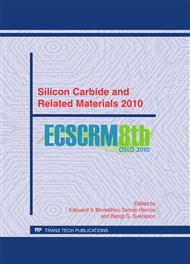p.539
p.543
p.547
p.551
p.555
p.559
p.563
p.567
p.571
3.3 kV Rated Silicon Carbide Schottky Diodes with Epitaxial Field Stop Ring
Abstract:
3.3 kV rated 4H-SiC diodes with nickel monosilicide Schottky contacts and 2-zone JTE regions were fabricated on commercial epitaxial wafers having a 34 m thick blocking layer with donor concentration of 2.2×1015 cm-3. The diodes were fabricated with and without additional field stop rings to investigate the impact of practically realizable stopper rings on the diode blocking characteristics. The field stop ring was formed by reactive ion etching of heavily doped epitaxial capping layer. The diodes with field stop rings demonstrated significantly higher yield and reduction of reverse leakage current. The diodes demonstrated blocking voltages in excess of 4.0 kV and very low change of leakage current at ambient temperatures up to 200 °C.
Info:
Periodical:
Pages:
555-558
Citation:
Online since:
March 2011
Keywords:
Price:
Сopyright:
© 2011 Trans Tech Publications Ltd. All Rights Reserved
Share:
Citation:


